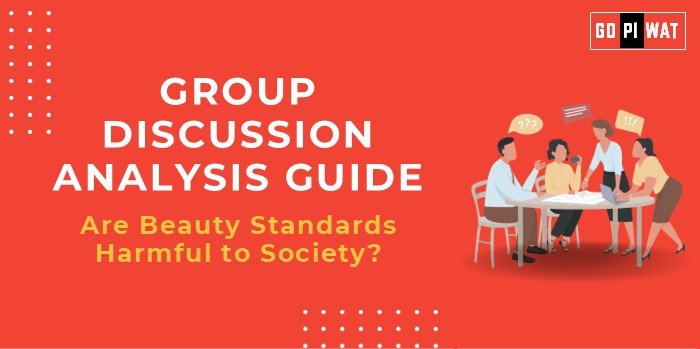📋 Group Discussion (GD) Analysis Guide: Are Beauty Standards Harmful to Society?
🌐 Introduction to the Topic
- 📜 Context Setting: “Beauty standards are societal benchmarks that define what is considered attractive. Historically shaped by cultural, media, and social influences, these standards have evolved over time. In today’s globalized world, the impact of beauty standards on mental health, self-esteem, and societal inclusivity has become a topic of significant concern.”
📊 Quick Facts and Key Statistics
- 📉 Body Dissatisfaction: Approximately 91% of women are unhappy with their bodies, highlighting widespread body image issues.
- 💰 Economic Impact: Unrealistic beauty standards cost the U.S. economy an estimated $501 billion annually due to appearance-based discrimination and body dissatisfaction.
- 📲 Social Media Influence: One in two girls say toxic beauty advice on social media causes low self-esteem.
- 💉 Cosmetic Procedures: The global cosmetic surgery market is projected to reach $66.96 billion by 2026, indicating a growing demand influenced by beauty standards.
- 🧠 Mental Health Correlation: Exposure to idealized body images is linked to increased body dissatisfaction and eating disorders among adolescents.
👥 Stakeholders and Their Roles
- 📰 Media and Advertising: Shape and perpetuate beauty ideals through content and imagery.
- 🛍️ Consumers: Influence market trends and demand for beauty products and services.
- 🩺 Healthcare Providers: Address the physical and mental health consequences of beauty standards.
- 🎓 Educational Institutions: Educate individuals on media literacy and promote healthy body image.
- 🏛️ Government and Policy Makers: Regulate advertising standards and implement policies to combat discrimination based on appearance.
🏆 Achievements and Challenges
✨ Achievements
- 🤝 Body Positivity Movement: Initiatives like Dove’s Real Beauty campaign have promoted diverse body representations, challenging traditional beauty norms.
- ⚖️ Legislative Actions: Countries like France have implemented laws requiring disclaimers on retouched photos to combat unrealistic beauty portrayals.
- 📚 Increased Awareness: Growing recognition of the mental health impacts associated with beauty standards has led to more supportive resources and discussions.
⚠️ Challenges
- 📱 Persistent Media Influence: Social media platforms continue to propagate idealized images, contributing to body dissatisfaction.
- 💸 Economic Pressures: The beauty industry capitalizes on insecurities, leading individuals to spend significant amounts on products and procedures.
- 🌍 Cultural Variations: Global beauty standards often marginalize non-Western beauty ideals, leading to a lack of representation.
Global Comparisons:
• South Korea: High prevalence of cosmetic surgeries reflects societal pressure to conform to beauty standards.
• Brazil: Known for a high rate of cosmetic procedures, indicating cultural emphasis on appearance.
Case Studies:
• France’s Photoshop Law: Implemented in 2017, requiring disclaimers on retouched images to combat unrealistic beauty standards.
• Dove’s Real Beauty Campaign: Launched in 2004, it has been instrumental in promoting body positivity and diversity in beauty.
📢 Structured Arguments for Discussion
- 💬 Supporting Stance: “Beauty standards drive the beauty and fashion industries, contributing significantly to the economy.”
- 🗣️ Opposing Stance: “Unrealistic beauty standards lead to widespread body dissatisfaction and mental health issues.”
- ⚖️ Balanced Perspective: “While beauty standards can inspire art and culture, their negative impacts on mental health and inclusivity cannot be ignored.”
📈 Effective Discussion Approaches
- 💡 Opening Approaches:
- Statistical Start: “With 91% of women unhappy with their bodies, it’s crucial to examine the societal impact of beauty standards.”
- Questioning Norms: “In an era of diversity, why do narrow beauty standards still dominate societal perceptions?”
- 💡 Counter-Argument Handling:
- Acknowledge Positive Aspects: Recognize the role of beauty standards in cultural expression and economic growth.
- Present Evidence-Based Rebuttals: Use statistics and studies to highlight the negative consequences of unrealistic beauty ideals.
📊 Strategic Analysis of Strengths and Weaknesses
Strengths
- 🎨 Cultural Expression: Reflect societal values and artistic expression.
- 💰 Economic Contribution: Drive industries such as fashion, cosmetics, and media.
Weaknesses
- 🧠 Mental Health Impact: Contribute to disorders like anxiety, depression, and eating disorders.
- 🚪 Exclusivity: Marginalize individuals who don’t fit the narrow standards.
Opportunities
- 🌍 Promote Inclusivity: Redefine beauty to encompass diverse appearances.
- 📚 Educational Initiatives: Implement programs to foster media literacy and self-acceptance.
Threats
- 🌀 Perpetuation of Stereotypes: Reinforce harmful societal norms.
- 💸 Economic Exploitation: Capitalize on insecurities, leading to unnecessary expenditures.
🎓 Connecting with B-School Applications
- 💡 Real-World Applications:
- Marketing Strategies: Develop campaigns that promote inclusivity and resonate with diverse audiences.
- Corporate Social Responsibility: Implement policies that address and mitigate the negative impacts of beauty standards.
- 💡 Sample Interview Questions:
- “How can businesses balance profitability with promoting healthy body images?”
- “What role does corporate responsibility play in shaping societal beauty standards?”
- 💡 Insights for B-School Students:
- Consumer Behavior Analysis: Understand how beauty standards influence purchasing decisions.
- Ethical Marketing: Learn to create campaigns that do not exploit societal insecurities.


